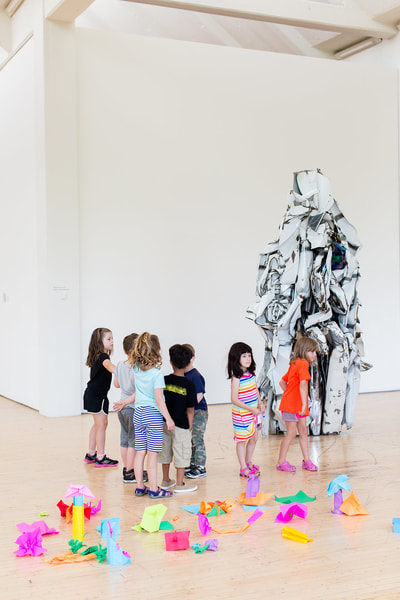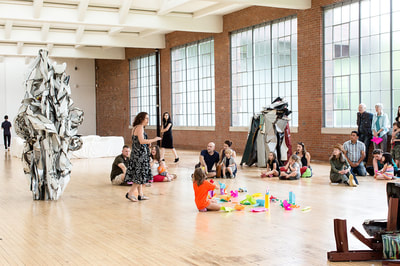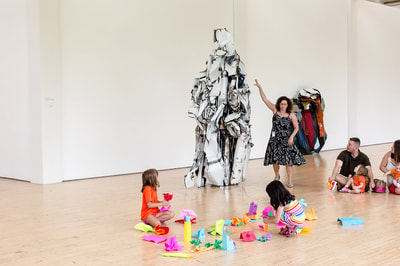 Photo: Eva Deitch
Photo: Eva Deitch "It's four-dimensional!" said a participant referring to Dan Flavin's installation, untitled (to you, Heiner, with admiration and affection) during a Family Tour I taught this month for the July Community Free Day at Dia: Beacon.
Four times a year, Community Free Days are offered at Dia: Beacon as a chance for visitors to engage and participate in playful, free public programming for all ages. I was honored to be asked by the Education Department to design and facilitate this interactive one-hour tour. Ever since I first visited Dia: Beacon back in 2006, I thought it would be the prime museum for a family program, an excellent place to engage young audiences and their adult companions in looking at shape, form, color, scale, texture, and light.
More recently, in my role as a Museum Guide (which I began at the beginning of this year), I have been studying and teaching from John Chamberlain. I thought Chamberlain's car sculptures would pair perfectly with a paper folding activity I learned many years ago from my art education professor at Teachers College Columbia University, Olga Hubard. Hubard writes about her teaching practice in her new book Art Museum Education. During Dr. Hubard's class, we visited the Noguchi Museum and responded to artworks following a paper exploration activity. At the Dia: Beacon, I combine this activity with viewing and discussing Chamberlain's work, along with Dan Flavin's installation, and Blinky Palermo's, Times of the Day.
At the start of the tour, participants discussed their observations about color and shape gathered from Palermo's use of paint on aluminum. We then discussed the differences between two-dimensional and three-dimensional artworks before participants created their own three-dimensional sculpture (individually or in groups) using colorful paper in the gallery space. Once everyone completed their sculpture, we carried them to the Chamberlain gallery to have a look at the various ways participants transformed their paper. We compared and contrasted the similarities to Chamberlain's large-scale sculptures, noting the bending, twisting, folding, and crumpling of both the paper sculptures and the steel and aluminum cars. Next, participants demonstrated and practiced bending, twisting, folding, and crumpling their bodies to mimic the forms of the artwork. After recreating the artworks in groups with their bodies, we headed to Flavin's installation to discuss color and form.
In front of Flavin's work, I asked the group whether or not Flavin's piece was two-dimensional or three-dimensional. Immediately, a youngster in the group, around six or seven years old, stated, "It's four- dimensional!" I hadn't anticipated her response, but in 4D movies, the fourth dimension is the physical effects of the space. For example, water splashing at the audience during a water scene. Or, air blowing to recreate the sense of the wind or a change in temperature. If applied to Flavin's arrangement of fluorescent lights, her answer was very astute!
Not only does Flavin's work include length, width, and depth, but the fourth dimension, which includes the light expanding out into space, painting the large room, engulfing viewers, and playing tricks with their eyes. If one stares at this particular work, which is green, and then looks toward the museum's adjacent large-scale windows, which lets natural (white) light in, one will see purple or pink light instead of white. After noticing that transition, when one stares back at the green fluorescent light blubs again, they appear white. If one looks at the artwork and space using a smartphone, similar variations of green, purple, and pink appear on the screen. It's a great place to take to take a portrait or selfie. I encouraged participants to make these shifts with their eyes and discoveries on their phones before we ended the tour.
I had a great time teaching and am thrilled to check "teaching families at the Dia: Beacon" off my bucket list. Thanks to Eva Deitch for taking photos of me teaching and for allowing me to feature them here on my blog.







 RSS Feed
RSS Feed